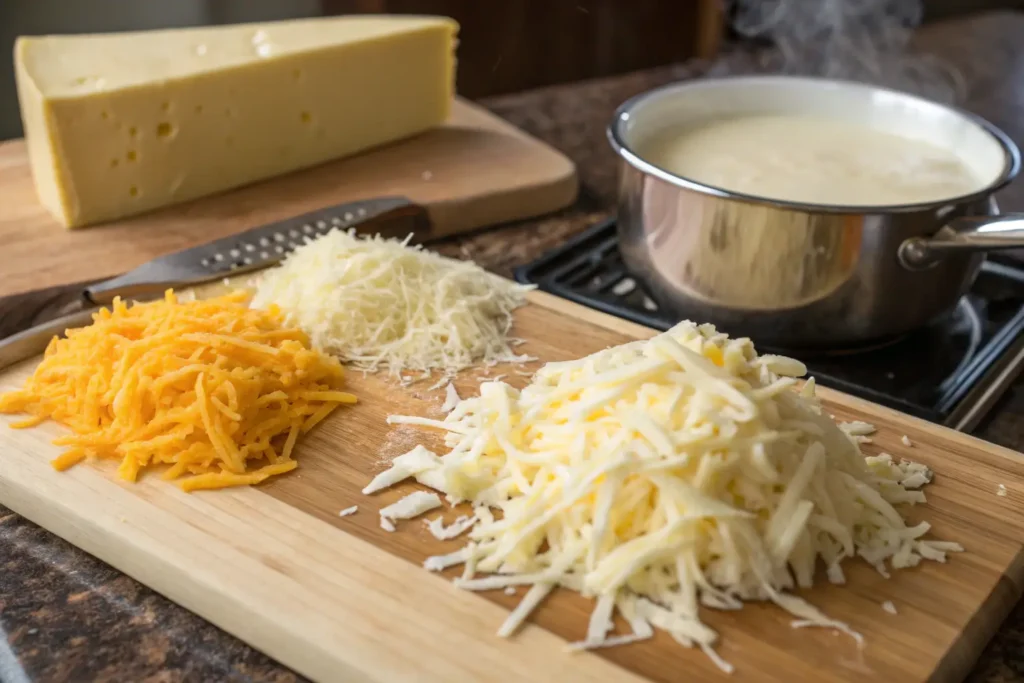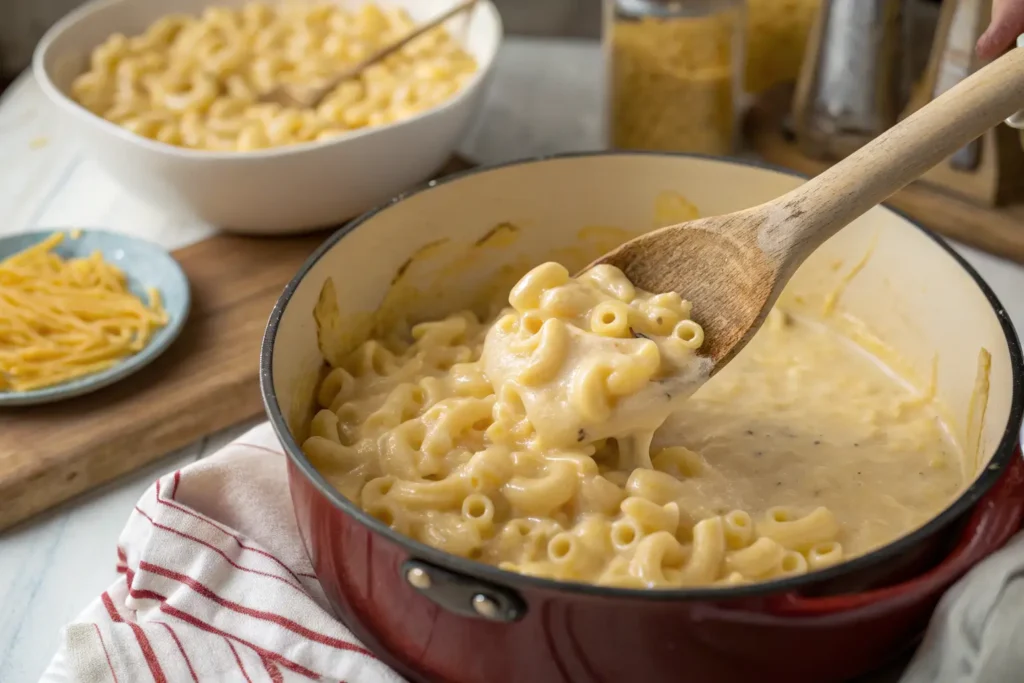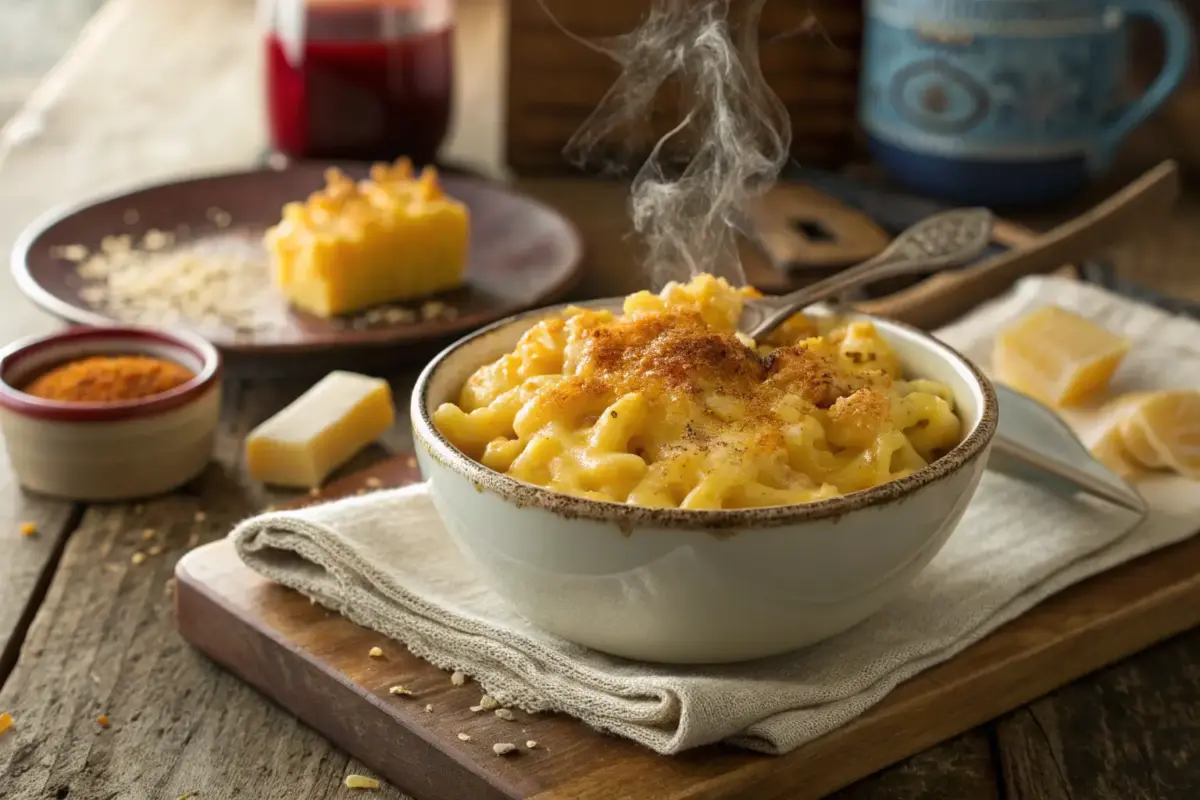Introduction
Let’s be real—mac and cheese is the ultimate comfort food. Whether baked to golden perfection or served creamy from the stovetop, it has a way of hitting all the right notes. But What Happens If You Put Too Much Cheese in Mac and Cheese? This isn’t just a question for the curious cook—it’s a common problem that can lead to unexpected results. In this first part, we’ll look at why balance matters and how understanding the science of cheese can help you avoid trouble.
The Science Behind Too Much Cheese in Mac and Cheese
How Cheese Melts and Blends with Other Ingredients

Cheese is a magical ingredient, but when you use too much cheese in mac and cheese, things can go awry. The way cheese melts depends on its fat and protein content. Some cheeses, like cheddar, melt smoothly, while others, like mozzarella, can get stringy. When cheese is overused, it can throw off the delicate balance needed for a creamy, cohesive sauce. This is why understanding how cheese behaves is key to avoiding clumps or oil separation in your mac and cheese.
Common Mistakes with Cheese Ratios in Recipes
One of the biggest reasons people end up with too much cheese in mac and cheese is the lack of clear guidance in recipes. Many simply say “add cheese to taste,” which can be misleading. Overloading on cheese not only overwhelms the dish with salt and richness but also disrupts the texture. To avoid this, stick to tried-and-true ratios: about 1.5 to 2 cups of shredded cheese per pound of pasta. This gives you the perfect balance without overdoing it.
Textural Changes from Using Too Much Cheese in Mac and Cheese
From Creamy to Clumpy: Texture Disruptions
When you use too much cheese in mac and cheese, the texture can take a hit. Instead of a creamy, smooth sauce, you might end up with a clumpy or rubbery mess. This happens because excess cheese introduces more fat and proteins than the liquid and starch in the sauce can handle. To avoid this, stick to measured amounts and add cheese gradually, ensuring the sauce remains silky and well-blended.
The Stringiness Factor: Why Too Much Cheese Can Overwhelm
Have you ever taken a bite of mac and cheese, only to find it stretching like a string of taffy? This is another consequence of adding too much cheese in mac and cheese. Stringy cheeses like mozzarella and provolone are prone to this effect, especially when used in excess. While a little stretch can be satisfying, too much turns the dish into an unmanageable mess. For a balanced result, combine stringy cheeses with smooth-melting varieties like cheddar or gouda.
Flavor Imbalances Caused by Too Much Cheese in Mac and Cheese
Overpowering Taste: When Cheese Dominates
Adding too much cheese in mac and cheese can completely overshadow the other flavors in your dish. Instead of a creamy, balanced bite, you’re left with an overpowering wall of cheese flavor. This doesn’t just drown out the subtle sweetness of the pasta and richness of the sauce—it can also make the dish feel monotonous. To avoid this, aim for a mix of cheeses that complement each other and balance their sharpness, creaminess, and saltiness.
How Excess Cheese Impacts Saltiness and Richness
Cheese is naturally salty and rich, which means adding too much cheese in mac and cheese can leave your dish tasting like a salt bomb. The richness can also become overwhelming, making it hard to enjoy more than a few bites. To prevent this, stick to the recommended cheese-to-pasta ratio and balance stronger cheeses like parmesan or blue cheese with milder options like Monterey Jack or Havarti.
How Too Much Cheese in Mac and Cheese Affects Consistency
Thickening Beyond Comfort: The Sauce Problem
One of the most common problems with too much cheese in mac and cheese is a sauce that’s so thick it feels more like paste. Cheese contains fat and protein, which thicken the sauce as they melt. When there’s too much of it, the sauce becomes overly dense, losing the creamy, smooth texture that makes mac and cheese so irresistible. The key to consistency is maintaining a balance between cheese, liquid, and starch.
The Role of Bechamel and Its Balance with Cheese
Bechamel sauce, a simple mix of butter, flour, and milk, forms the base of most mac and cheese recipes. When you add too much cheese in mac and cheese, the bechamel can’t perform its job of creating a creamy, smooth texture. Instead, the sauce may become grainy or clumpy. To avoid this, gradually add your cheese to the bechamel while whisking over low heat. This ensures everything melts evenly, resulting in a cohesive sauce.
Potential Cooking Problems with Too Much Cheese in Mac and Cheese
Overcooking Cheese: When Heat Works Against You
Cheese is a delicate ingredient, and overcooking it is a surefire way to ruin your mac and cheese. When you use too much cheese in mac and cheese, the proteins in the cheese are more likely to tighten up when exposed to high heat. This leads to a gritty, rubbery texture. To prevent this, keep the heat low and avoid prolonged cooking times once the cheese is added.
Grainy or Oily Sauce: Understanding Separation
Have you ever had a mac and cheese sauce that separates into a greasy layer on top? This often happens when you use too much cheese in mac and cheese. The fat in the cheese separates from the proteins, resulting in an unappetizing, oily mess. To fix this, always add cheese gradually and stir it into a slightly cooled sauce. Combining cheeses with different melting properties can also help stabilize the sauce and keep it smooth.
Fixing a Mac and Cheese Dish with Too Much Cheese
Diluting the Cheese Sauce with Additional Pasta

What happens if you put too much cheese in mac and cheese? Well, the dish can feel overly rich, clumpy, or even too salty. One of the simplest solutions is to add more cooked pasta. The extra pasta absorbs the excess cheese and balances the overall flavor. Make sure your pasta is cooked al dente, so it holds its texture when combined with the sauce. Start with a cup of additional pasta and adjust as needed—sometimes, that’s all it takes to restore balance.
Adjusting the Bechamel or Liquid Ratios
If adding more pasta doesn’t fully fix the problem, thinning the sauce is your next move. Adding a splash of warm milk, cream, or even chicken broth can bring the sauce back to the creamy texture you want. This is especially helpful when the sauce becomes too thick due to an overload of cheese. Warm the liquid slightly before stirring it in to ensure smooth incorporation. Alternatively, you can prepare a small batch of bechamel and mix it into the existing sauce to stabilize the texture.
Balancing Flavors with Other Ingredients
When the cheese flavor becomes overpowering, it’s time to bring in other ingredients to balance it out. Fresh herbs like parsley or chives can cut through the richness and brighten the dish. For a subtle touch of acidity, try adding a squeeze of lemon juice or a splash of white vinegar. These additions work wonders to lighten the dish and enhance the overall flavor without masking the cheesy goodness.
Preventative Tips for the Perfect Cheese Ratio
Choosing the Right Types of Cheese for Balance
Not all cheeses behave the same in mac and cheese, and choosing the wrong combination can lead to problems. If you’re wondering what happens if you put too much cheese in mac and cheese, the answer often depends on the type of cheese you’re using. Sharp cheddar offers bold flavor, while creamy cheeses like fontina or Havarti add smoothness. Avoid using only stringy cheeses like mozzarella, which can create an overly stretchy and sticky texture. A good rule of thumb is to mix three to four complementary cheeses for the best results.
Measuring Cheese Properly for Consistency
Precision matters when making mac and cheese. To avoid the dreaded problem of what happens if you put too much cheese in mac and cheese, stick to a recommended ratio of 1.5 to 2 cups of shredded cheese per pound of pasta. If you’re tempted to add more, go slowly and taste as you go. You can always add more cheese later, but taking it out is impossible. Freshly shredded cheese also melts better than pre-shredded varieties, so opt for fresh whenever possible.
FAQs
What happens if you add too much cheese to mac and cheese?
Adding too much cheese can lead to an overly thick, clumpy sauce with an overpowering flavor. It may also become too salty or greasy, making the dish less enjoyable. Balancing the cheese-to-pasta ratio is key to avoiding these issues.
How to fix a dish that’s too cheesy?
If your mac and cheese is too cheesy, you can fix it by adding more pasta to dilute the cheese-to-pasta ratio. You can also thin the sauce by adding warm milk, cream, or bechamel. For overly salty flavors, balance them with fresh herbs or a splash of acidity.
How much cheese should you put in mac and cheese?
The ideal amount of cheese is 1.5 to 2 cups of shredded cheese per pound of pasta. This ensures a creamy, flavorful sauce without overwhelming the dish. Adjust the amount based on the types of cheese you’re using for the perfect balance.
How do you fix messed-up mac and cheese?
For thick or clumpy mac and cheese, add warm milk or cream to thin the sauce. If the dish is too salty, balance it with unsalted ingredients like extra pasta or bechamel. For grainy or oily textures, gently reheat and whisk the sauce until smooth.
Conclusion
What happens if you put too much cheese in mac and cheese? It can disrupt the balance of flavors, textures, and even the cooking process. However, with the right fixes—like adding more pasta, thinning the sauce, or balancing flavors—you can save your dish and make it delicious again. And by following preventative tips like using the right cheese combinations and proper measurements, you can avoid these issues altogether. So next time you’re making mac and cheese, remember: balance is everything. Happy cooking!
Explore More Mac and Cheese Inspiration:
If you’re curious about enhancing your mac and cheese, don’t miss our guide on Why Use Evaporated Milk in Mac and Cheese?, where we explain how this secret ingredient adds creaminess and depth. For fans of traditional recipes, our Old-Fashioned Baked Macaroni and Cheese is a timeless classic that’s sure to please. Feeling adventurous? Try our indulgent twist with Beef Queso Mac and Cheese for a hearty, flavor-packed dish that combines cheesy goodness with savory beef.


4 thoughts on “What Happens If You Put Too Much Cheese in Mac and Cheese? (And How to Fix It)”